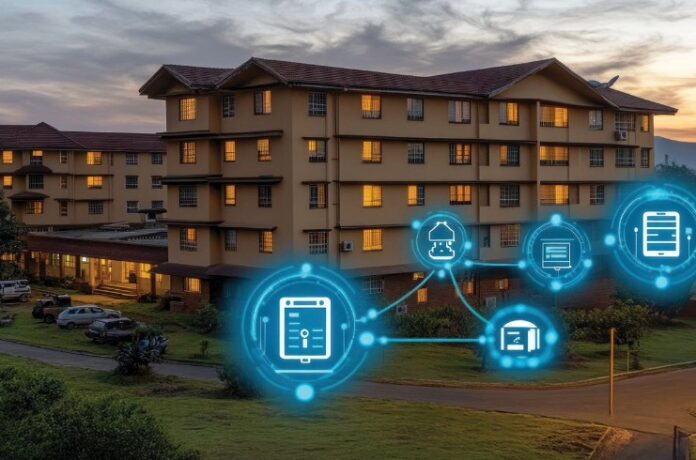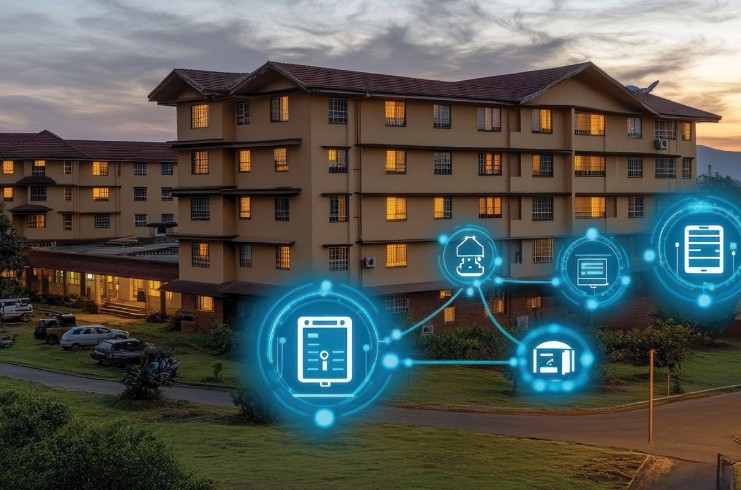
Guests expect personalized, efficient service, frontline hotel teams expect to have the bandwidth to deliver that service and succeed in their jobs, and managers expect to have the data needed to make the best operational decisions. Helping to meet expectations on all sides are best-in-class property management systems (PMSs), which are continually enhancing their functionality, and in many cases, leveraging AI to do so. While they are cutting-edge examples of machine intelligence, these PMSs share a key purpose with the many innovative machines of the Industrial Revolution: saving labor time.
Task automation has become especially critical in today’s hotel industry, observed Priya Rajamani, SVP of implementation & support, Stayntouch. “Persistent labor shortages and high employee turnover continue to challenge hotels across the globe, making it harder to maintain consistent service levels and operational efficiency,” she said. “With fewer hands available, hotel teams must find ways to do more with less—without burning out or compromising the guest experience. Best-in-class PMSs help alleviate this pressure.”
The list of PMS task automations is ever evolving, with examples including:
- Automated mobile check-in and check-out
- Mobile key delivery
- Housekeeping task management based on real-time occupancy and priority status
- Reporting and administration, such as reservation confirmations, folios, invoicing, and payment collections
- Guest communications
Intuitive Interface
Leading PMSs couple these labor-saving functions with a user-friendly interface, a key aspect that “can reduce training time from weeks to just a few hours—especially valuable when onboarding seasonal or temporary staff,” said Rajamani. “This not only boosts productivity but also helps retain staff by making their day-to-day tasks more manageable and less stressful.” With the industry’s challenge in reducing turnover, “you need to get [new hires] up to speed in a fast and productive manner,” said Adam Harris, co-founder and CEO of Cloudbeds. “So, we asked our user experience team to design a system that’s like modern applications. It needs to be fast and easy, and it does not need to look like traditional lodging systems. … We needed to drop the average learning process of 40 hours to less than five hours of training.”
Audrey MacRae, executive vice president, Maestro, elaborated on the features that make for an intuitive interface, using her company’s platform as an example: “Our role-based dashboards highlight the most relevant task and information for each team member, so they see exactly what they need. Everything is logically organized with universal design-focused icons, intuitive menus, and naturally placed action buttons to prevent confusion and streamline workflows,” she described. “Based on user feedback, we’ve also introduced innovations like Maestro Touch, which is a specialized tablet and touchscreen-optimized interface that gives staff quick, mobile access to key operational tools, allowing them to complete check-ins and synchronize data across departments from wherever they are.”
A robust e-learning resource is also an important source of support for PMS users. “Our self-service university onboards over 70,000 hotel employees around the world every single week,” said Harris. “It is a fully guided experience to get certified on Cloudbeds. It’s got front desk staff trainings, SOP guidelines … just a plethora of knowledge around the hotel industry, but also system training.”
Paving the Way to Personalization
The basis for creating the personalized experience that today’s guest expects is the rich guest profiles that modern PMSs produce through ongoing data collection from visits to single or multiple properties. That data typically includes stay history, room preferences, communications history, loyalty activity, spending behavior across different channels, and more. “A unified guest profile allows operators to instantly recognize returning guests, personalize communications, and offer tailored upsells or amenities that match individual preferences,” MacRae explained. “Operators get a real-time view of each guest’s preferences, behavior, and history, all in one place.”
PMSs that include mobile upsell tools enable guests to customize their own experience, e.g., selecting a late check-out, a higher floor room, or a bottle of wine on arrival—“turning preferences into profit while enhancing satisfaction,” as Rajamani put it. “These upsell options are delivered via automated messages that are timed and tailored to each stage of the guest journey. In addition, attribute-based selling allows hotels to move beyond rigid room categories. By letting guests select specific room features—like a balcony, view, or layout—hotels can more closely match offerings to individual preferences, increasing both conversion rates and guest satisfaction.”
Guest Communications
Real-time communications with guests are an integral part of their experience, and PMSs are increasing the efficiency of those interactions. For example, Maestro’s GuestXMS captures and consolidates communications, service requests, in-stay surveys, and post-stay feedback in real time. “The built-in SMS/text messaging platform enables two-way communication between guests and staff, whether a guest needs extra towels, wants to extend their stay, or has inquiries about local attractions, staff can respond instantly,” MacRae explained. “Automated messaging sequences timed around reservation status (e.g., pre-arrival, day-of, post-stay) keep guests informed without overwhelming the team. This information allows hotels to personalize services based on guest preferences, resolve issues quickly onsite, and personalize future offers and experiences to boost loyalty.”
AI-Enabled PMS
AI is becoming a major support for staff in guest communications. Harris gives examples of how Cloudbeds’ AI voice engines proactively handle a variety of interactions, from upgrade requests to maintenance issues. “We had a guest call in who mentioned they were celebrating their 10-year anniversary and requested an upgrade. The AI voice engine Engage booked the upgrade, synced the new room assignment, and flagged that there was a high lifetime value of this guest because it was a repeat guest. Housekeeping automatically received the task to deliver champagne and flowers, and the F&B department was alerted. On their arrival, the concierge received a flag right next to their reservation [indicating] confirmation time and the offer. All of this was automated,” he described.
“At one of our Las Vegas hotels that’s using our voice engine, we were able to detect a water pressure issue before maintenance was able to detect it. The hotel was getting phone calls—‘Hey, my water is not working’—and we saw a spike in those calls. And because our team was listening to some of these conversations, we flagged it, put a request in, and they fixed it. In the future, an AI engine would look for those signals and be able to handle it.”
Of course, chatbots are just one application of AI within PMS technology; developers are extending AI-powered automation to a multitude of operational processes, from housekeeping task distribution to rate strategy. Accurate forecasting is a key contribution of AI, Harris stressed. “We have a causal AI engine that can predict with a 96 percent confidence level what a [key metric] is going to look like 180 days out,” he noted. Based on that prediction, “we can make recommendations on how you staff, handle pricing, change allocations on online travel agencies, send campaign emails to guests with personalized offerings, plan renovations and maintenance,” etc.
Behind-the-Scenes Role
While the functionality of AI-powered PMSs is continually growing, the proper role of the technology is arguably “behind the scenes,” with people remaining at the focal point of guest-facing hospitality. “The real strength of AI in hospitality isn’t in flash front-end robotics, but in its ability to work quietly in the background, automating repetitive back-office tasks, ensuring data accuracy, and highlighting timely insights to help teams operate with greater precision and agility,” explained MacRae.
And while chatbots are an increasingly effective labor-saving tool that is not behind the scenes, they are not the main value proposition of an AI-powered PMS, Rajamani maintained. “While some vendors are eager to push AI into guest-facing applications, today’s models still struggle with answering complex questions or providing the empathy and nuance guests expect,” she argued. “Rather than enhancing service, such applications risk putting a digital barrier between staff and guests. That’s why the true value of AI lies behind the scenes.”
Migrating to the Cloud
A slow adoption curve despite the advantages of the cloud-based PMS
Cloud-based PMS platforms increase efficiency by enabling staff to access the PMS remotely from any authorized device to complete tasks ranging from checking in guests to updating room statuses to managerial oversight. In addition, “no onsite servers means no capex. It means you always have the latest version of your software,” said Adam Harris, co-founder and CEO of Cloudbeds. “We have over 500 different integration partners that don’t rely on an IT person to install a connection that has to then talk to the cloud.”
Despite the flexibility and scalability of the cloud, some hoteliers still have valid reasons to deploy an onsite PMS, explained Audrey MacRae, executive vice president, Maestro. “Some operations may prefer having their servers and infrastructure managed locally by their staff, especially where Internet reliability is a concern.” But others have not migrated to the cloud simply because they are behind the curve when it comes to technology. “There is quite a big part of our industry that’s still stuck on on-prem [PMSs] and have not made the migration,” Harris observed. “And that might be a cost reason or a lack of understanding of what the benefits are. I think it’s because our digital adoption curve as an industry is one of the lowest, [even though] we’re one of the biggest industries in the world. So, we need to educate around that.”

